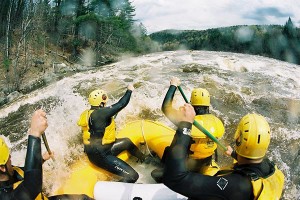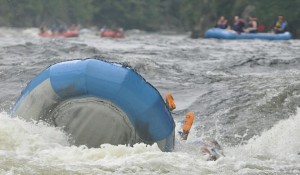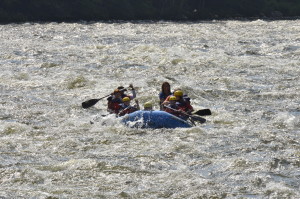Over the years, Scouts and their leaders have experienced white water activities which have included Class V rivers. Indeed, Scouts attending Bechtel Summit Base had the opportunity to raft on a Class V river. But, no more!

Note the 2019 edition of the Guide to Safe Scouting, page 18 (Safety Afloat):
- “Self-guided unit trips on Class III whitewater may only be done after all participants have received American Canoe Association or equivalent training for the class of water and type of craft involved.”
- “Unit trips on whitewater sections of rivers rated Class IV are only allowed in rafts with a professionally trained guide in each raft.”
- “Trips above Class IV are not allowed.”
The above restriction on “trips above Class IV” is new to the Guide to Safe Scouting effective 2017 in relation to the prior editions of the Guide. This means that there are more than a few white water rivers which are no longer acceptable program choices for white water rafting, including the Class V river once used by Bechtel Summit Base!
Also, the restriction of only rafting on rivers rated Class IV is new to the Guide.
It is believed that such restrictions result from several incidents that have occurred during the past several years on rivers now falling within the restricted classes of whitewater. For a youth-based organization where a youth may or may not be able to recognize the risk associated with such activities, this is a prudent restriction on river activities involving Scouts, not to mention accompanying adults.

Of course, whether a section of a river is determined to be Class III, Class IV (or Class IV+) or Class V may be in the eye of the beholder, and also based on changing water flow, etc.
However, while it may reduce risk by both prohibiting use of rivers having rapids in excess of Class IV, and limiting Class IV boating to professionally-guided rafts, focusing SOLELY on the difficulty of a particular river does NOT guarantee a safe trip.
According to American Whitewater, whitewater fatalities (1972-2016) ranged across the board when it comes to river difficulty:

- Class I-II – 16% of fatalities
- Class III – 36% of fatalities
- Class IV – 26% of fatalities
- Class V – 22% of fatalities
For instance, the water flow conditions may make the river too risky for both youth and their leaders to responsibly traverse, irrespective of the class of rapids – which is where judgment comes into play! There are multiple instances of scout groups attempting to boat or raft on rivers whose flow rates were significantly above normal, with undesirable outcomes.
Indeed, it is reported that in Colorado during 2019’s spring/summer rafting season, due to the heavy winter snow pack and resulting high river water levels, 18 people either died or are missing as a result of recreational river activities. See, this 2019 story about a whitewater rafting death involving a scout leader in Colorado, purportedly on Class III rapids, during high flow rate conditions. Note also this 2009 story of a scout leader drowning on the Snake River in Wyoming during a time when the water flow was significantly higher than normal. And, this 2016 story about a scout leader drowning during a white water rafting trip on the Dead River in Maine.
A common factor in such incidents is the ability (or lack thereof) of the participant to survive being dumped into the river, whose conditions (flow rate and temperature) may have been beyond those ever faced by that person, and which are clearly beyond those faced when doing a swim test in a pool or lake, and whose physical condition and water skills may not have been up to the task.
Again, this is where judgment comes into play, for both the river guides and the adult leaders . . . particularly for a youth-based activity. The question to be asked is, “Is it prudent to place the youth and adults in this group on this particular river, at this particular time?” You can’t be certain that the river guide will ask that question, or arrive at the correct answer.
Safe boating!
